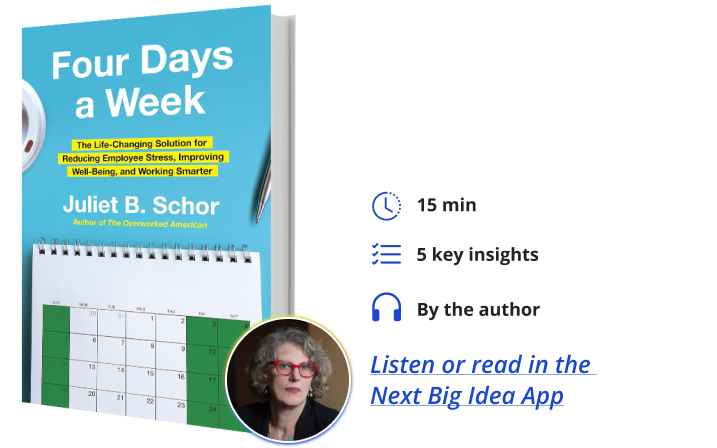Juliet Schor is an economist and sociologist who specializes in the study of work. She is a Professor of Sociology at Boston College, having previously taught at Harvard for 17 years. Her previous books include the national bestseller The Overworked American. Juliet has received numerous awards for her research and writing and has had her work published in scores of magazines and newspapers, including the New York Times, Wall Street Journal, Newsweek, and People magazine, as well as made several appearances on popular newscasts.
What’s the big idea?
For a while, the concept of a four-day workweek seemed aspirational—utopian, even. However, it is now more realistic than ever. Research increasingly shows that switching from five to four is a win for employees and their entire company. Well-being increases (and stays that way), retention is solved, and heightened productivity replaces fatigue and stress. The benefits are so impressive that governments are getting involved in legislating fewer working hours. Times are changing, and modern life and modern business are better off on a four-day work schedule.
Below, Juliet shares five key insights from her new book, Four Days a Week: The Life-Changing Solution for Reducing Employee Stress, Improving Well-Being, and Working Smarter. Listen to the audio version—read by Juliet herself—in the Next Big Idea App.

1. The four-day week is life-changing for employees.
Between dual-earner households, the faster pace and complexity of modern life, and intensifying job demands, we’ve heard over and over that “two days is not enough” to manage life admin, family and friends, and recovery from the workweek. Around the world, levels of stress, burnout, and disengagement remain at historically high levels. That’s a big part of why we find that a third day off is transformational. Physical and mental health, sleep, fatigue, and anxiety all improve, according to survey and biometric data. Stress and burnout are reduced. People are happier and more engaged in their work.
The obvious reason a four-day week is transformational is the ability to work less. In our statistical modeling, we found that the larger the working time reduction, the bigger the well-being impacts. People who manage to reduce their time by a full eight hours per week experience about twice the improvement in well-being.
When we drill down to see what it is about working less that makes people so much better off, two factors emerge. About half the increase in well-being is due to behavioral changes outside of work, such as better sleep, more exercise, and less fatigue. The other half is that people register much higher levels of effectiveness and performance at work.
2. Working less boosts productivity.
We discovered that people are much more productive on a four-day week. They report being able to find more efficient ways to do things. People report that they’re no longer experiencing the Sunday Scaries, and they show up on Monday mornings feeling refreshed, rather than anxious. They feel more on top of their workloads and score higher on a “work smart” scale. They do a better job prioritizing what’s important, spend less time spinning their wheels, and are more motivated to get through their to-do lists. These individual impacts collectively contribute to the organization’s overall success.
Companies tell us they are maintaining or increasing overall productivity when they switch to a four-day workweek. That’s counterintuitive if we assume that productivity mainly depends on how long we work. But there are several reasons for better performance. Staff are healthier, more energetic, and more loyal. Organizations become more intentional and invest in the upfront work that saves time in the long run. Customer service-facing organizations in the tech world tell us they have finally gotten serious about documentation. Other companies report eliminating unnecessary forms or bottlenecks in approval processes. These are all examples of the “forcing function of the 4DW.” It makes organizations do things they know will save time but have been too busy to accomplish.
“Organizations become more intentional and invest in the upfront work that saves time in the long run.”
The other major effect is that the four-day week stops resignations dead in their tracks. In one of our most successful cases, the manager explained that, on her team, turnover went from 30 percent a year to zero. That 30 percent turnover figure is common in her industry, and solving it avoided the wasted time of onboarding and training new people, which yielded a better product and higher sales. At a hospital we studied, the opportunity for overworked nurse managers to get a third day off led to many rescinded resignation letters. At a restaurant (another high turnover industry) people also stopped quitting.
A four-day-a-week job is much more valuable to people. About 15 percent of our sample says that no amount of money could induce them to return to a five-day schedule. Many more would require a significant pay increase to return. That’s why when people get a four-day week, they don’t leave.
3. A whole organization transformation.
For years, companies have tried to address employee stress and burnout with individual solutions. They’ve tried flex time, scheduling accommodations, wellness classes, yoga, and mindfulness. The academic research shows that none of these works. Stress and disengagement have only gone up. Those on shorter schedules often suffer stigma or get paid less, but end up doing as much work as before.
In contrast, reducing hours across the entire organization is a real solution. In the trials we studied, companies received two months of training on how to implement the 4DW before they began. How is “making it work” defined? Well, there is some variation across companies, but generally, it’s defined as doing five days’ work in four.
Companies were coached on ways to get inefficient meeting cultures under control and to create focus time. They learned about new time-saving software or how to analyze their processes to eliminate wasted steps. They achieved success because it wasn’t just on individuals, but everyone was pulling together to change the culture. That results in a true shift in work norms, shifting from the facetime/productivity theater model to one that’s focused on results.
4. Almost all the companies who try it stick with it.
Our team wanted to know if the great results we saw would persist. So, we went back to the companies at one and two years in. We found that improvements in employee well-being were remarkably stable.
“Almost all the companies stayed on the four-day schedule.”
Perhaps more surprisingly, almost all the companies stayed on the four-day schedule. Some instituted a few tweaks to their programs, but only about 10 percent reverted to five days after a year. If we exclude those who never really gave it a try, it’s closer to 5 percent. Maintaining or raising productivity, improving product quality, reducing turnovers, and getting happier, more satisfied employees is a recipe for success.
5. The four-day week is coming.
It has been 85 years since the workweek was last reduced. Since the pandemic, pressure has been building, especially in the U.S., where working hours have been increasing. There is plenty of anecdotal evidence that Fridays are evolving away from a standard workday. Working from home is accelerating this process.
But it’s not just an organic evolution to the four-day week that we’re seeing. Governments are beginning to encourage or even legislate worktime reduction. The Polish government has just announced a pilot program similar to the ones we’ve been studying. This follows similar pilots by the governments of Spain, Scotland, Belgium, Portugal, and the Dominican Republic. The government of Tokyo has recently implemented a four-day workweek for all its employees. Spain has just legislated a reduction in the workweek for the entire country to 37.5 hours per week. Recently, two bills to run pilots were filed in New York state, making it the 11th state considering legislation. And a growing number of local governments are shifting to a four-day week for their employees, with some saving money in the process.
AI will accelerate the shift to four. As companies incorporate AI at a rapid clip, society is faced with a stark choice: Are we going to lay off millions of people? That’s a possible outcome with a technology that can replace so much human labor.
But it’s not our only option. We could follow the path we took with the first industrial revolution. We can use that labor-saving technology to reduce working hours and keep employment high. That’s the path we should—and I think will—take. I started researching worktime reduction many years ago. At the time, it was seen as aspirational, even utopian. But that has flipped, and now the four-day week has become common sense. It is also the smart option if we want to protect our economy, democracy, and society.
Enjoy our full library of Book Bites—read by the authors!—in the Next Big Idea App:































